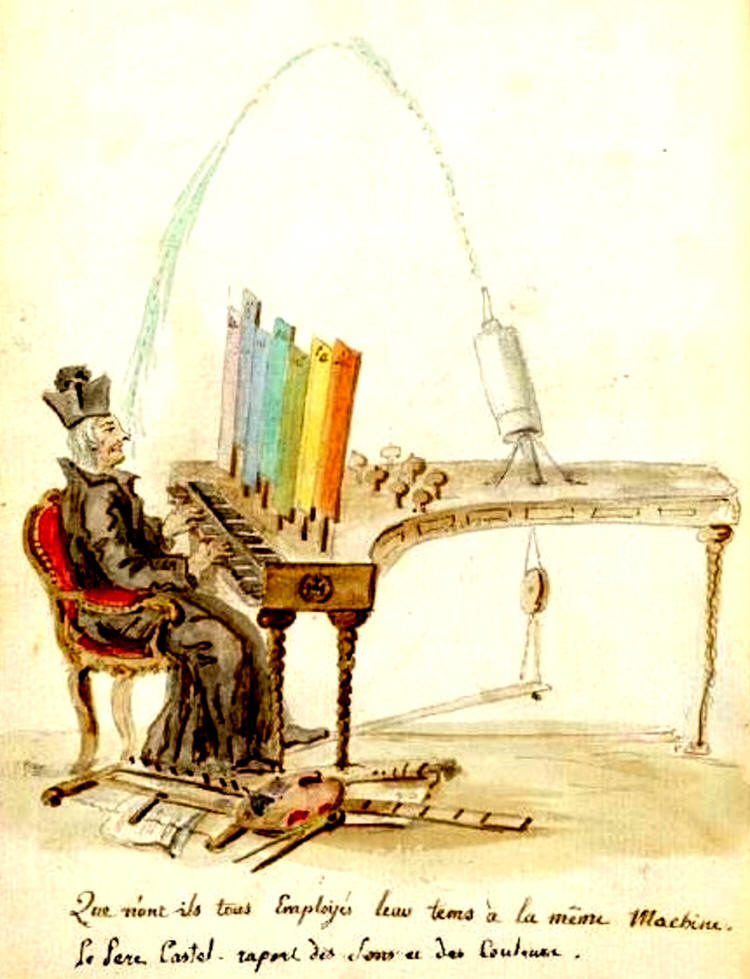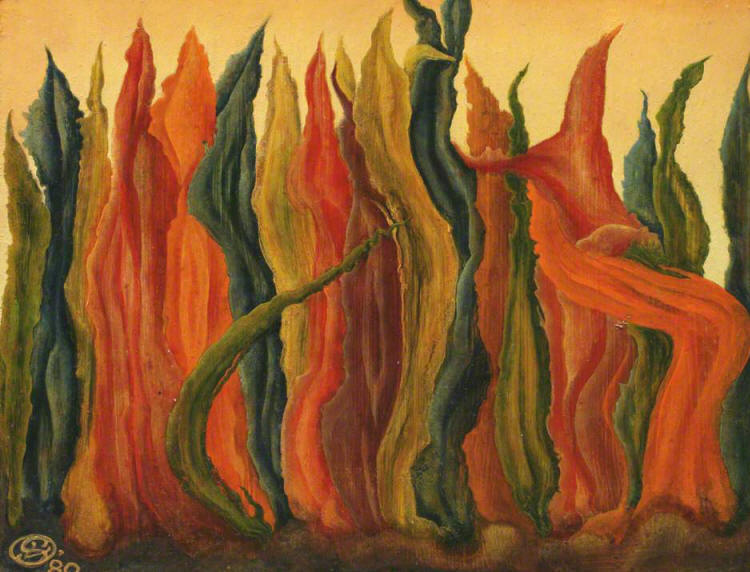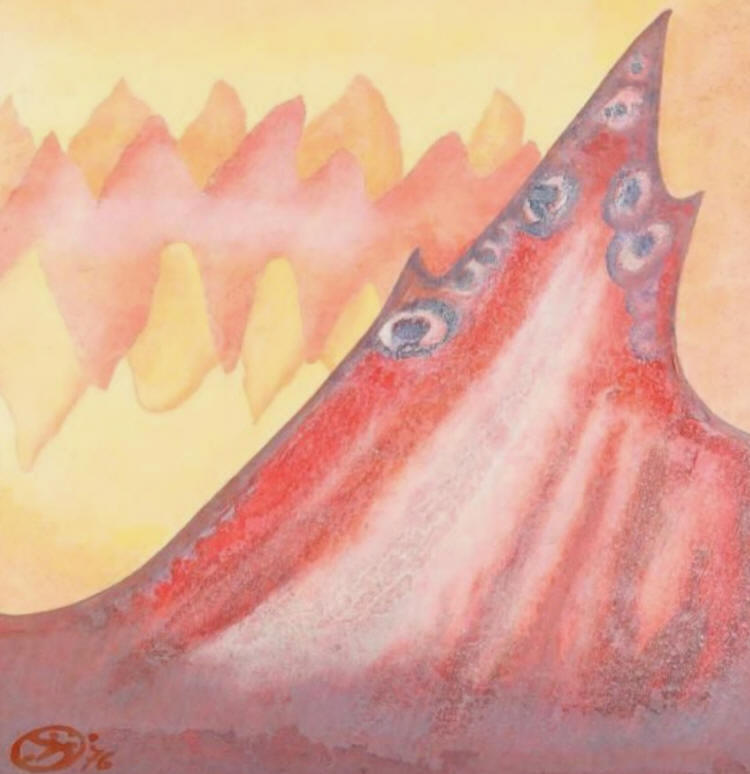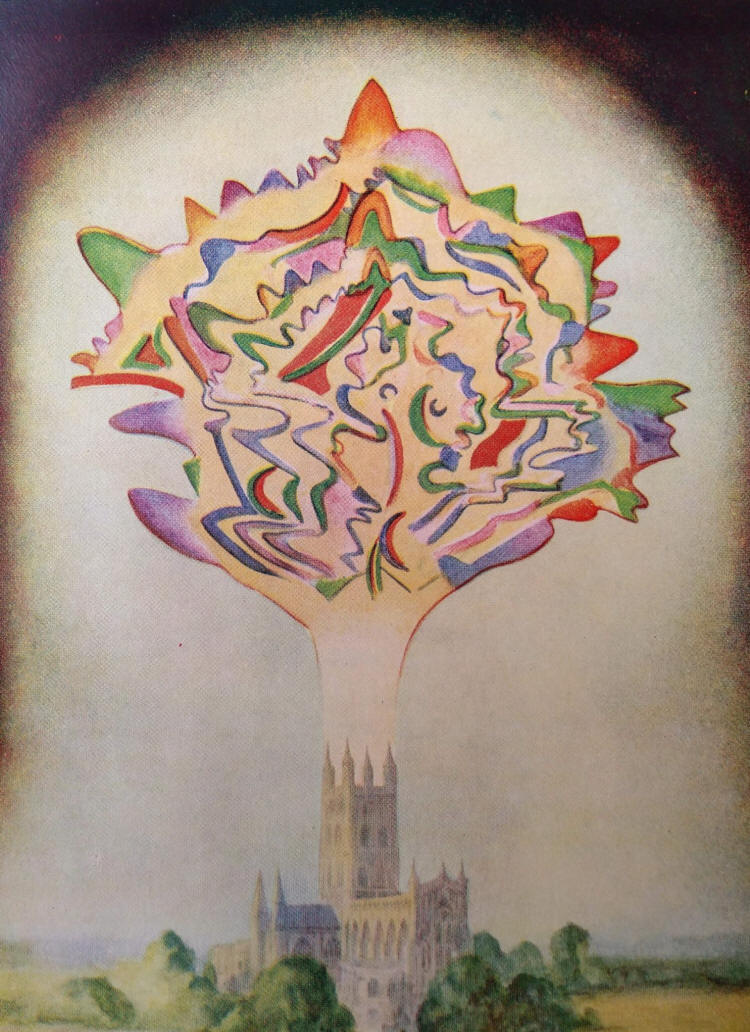|
|
| home | exhibitions | interviews | features | profiles | webprojects | archive |
|
What colour is three o’clock? Ithell Colquhoun and synaesthesia Richard Shillitoe
Synaesthesia One of the most common forms is colour-sound synaesthesia, occurring when a sensation of colour results from hearing a sound. It can be highly nuanced: the same note may result in a different colour being seen depending on such factors as the instrument it is played on, the timbre of the sound, and whether the note is heard in isolation or is part of a chord or melodic sequence. Notes that are higher in pitch are generally lighter in colour than lower notes, which are commonly darker hued. The colours may be seen as external to the body, in some inner space, or simply ‘seen’ without any identifiable spatial location. As if all this isn’t strange enough, synaesthesia often involves more than just the senses. Varieties occur that involve highly sophisticated brain functions, such as language and conceptual thinking. An example of such cognitive synaesthesia is when a symbol (such as a letter, a number, or even a time unit) is systematically associated with a sense such as a smell or a colour (e.g. Tuesday may always be coloured green). Furthermore, a shape that can be read as the number 2 or as the letter Z will induce different colours if it is mentally processed as the number or the letter. This indicates that synaesthetic experiences can be influenced by culture and education and are not entirely ‘wired-in’. One important type of cognitive synaesthesia is sequence-space synaesthesia, in which ordered sequences such as the minutes of the hour or the months of the year are seen spatially. They may, for example, form an array such as a circle, around or in front of the body. It is only recently that synaesthesia has caught the attention of scientists, principally neurobiologists intent on mapping relevant brain structures and psychologists investigating cognition and linguistic development. Some researchers now think synaesthesia forms a continuum with normal perceptions rather than being a discrete phenomenon. If they are right, and if synaesthesia can be taught or enhanced, then estimates of its prevalence, frequently put at about four percent of the population, are likely to be an underestimate and the number of variants that are currently recognised (at least sixty one) will almost certainly need revising. I should also mention that altered states of brain chemistry can lead to temporary synaesthesia. Typically, this arises from the use of psychoactive drugs or from certain ritual practices. In shamanistic trances, for example, practitioners induce an altered state of consciousness, frequently through rhythmic drumming or chanting, during which the senses blend and lose their distinctiveness. In this state shamans are able to access the world of animals, spirits and ancestors, and free-up their latent powers of healing. This essay is not concerned with induced synaesthesia of this sort as there is no evidence that Colquhoun explored altered states either through recreational or ritualistic activities. With all this in mind, we should now be in a position to gauge whether any of Colquhoun’s own experiences provide proof of synaesthesia.
Games
Colquhoun’s descriptions are strong contenders for sequence-space synaesthesia and colour-space synaesthesia. An example of the former is her memory that the letters of the alphabet formed a long descending stair, and of the latter, the complex associations she reports between colours and spatial dimensions. These are not the same as the kinds of associations sometimes found in the public at large. Non synaesthetes, for example, will often order numbers, letters or days of the week sequentially in their mind’s eye, especially when performing mental calculations of the sort “if the 17th was a Thursday, what date was the previous Monday?” But when they do this, they typically follow the layout appropriate to their culture: the days and the numbers will probably travel from left to right or occasionally vertically as though reading from a chart or calendar. Just as importantly, when people do this they can only do so deliberately, on demand, and only whilst maintaining concentration. And, of course, the formations are conjured up imaginatively, rather than being actually perceived. By contrast, Colquhoun’s sequences are unforced, unbidden and form highly distinctive spatial paths: the months form a ‘bellying garland’, numbers mount ‘a long stair’ whilst letters follow a downward trajectory. She once made illustrations of these sequences. One shows the months as small blocks of colour strung out in an arc with a distinctive upturn at the year end. Another shows the letters of the alphabet forming a descending arc, just as she describes.² The reference to a pentatonic scale of colours is not entirely clear, but it seems to indicate that she could differentiate a scale of five colours, relating to an object’s relative altitude. This may be no more than an uncharacteristically awkward piece of writing, but it is worth remembering it is one of the defining characteristics of authentic synaesthetic perceptions that whilst the person acknowledges their reality, they are also aware that they are in some way different to regular perceptions. This can obviously cause difficulties when trying to describe them with any precision and Colquhoun clearly struggles with putting them into words. Her remarks that “there were other colours … for which only an approximation can be made” and that they had “endless chromatic and geometrical variations” are also consistent with this. Her remarks are, in fact, very similar to Wassily Kandinsky’s description of his personal experiences when he wrote that he saw colours “which I cannot put into words and which I can only poorly depict with my palette.”³ Kandinsky was an undisputed synaesthete, although in his case, colours were induced by sounds not the positions of objects in space. For most synaesthetes, their perceptions are constant and lifelong. Colquhoun’s descriptions are also sometimes unclear on this point. When she writes of certain colours “I cannot now clearly see” she seems to be indicating that her perceptions have faded with the passage of time. However, she also states that her word-colour perceptions have changed over time, although in this case it “all grows more complex” as her proficiency in other languages has increased and new meanings become attached to words. This increasing complexity may account for the decreasing clarity and perhaps she was also trying to understand and describe the consequences of the symbolic confusion I referred to earlier when a symbol such as S is interpreted as the symbol 5. The multi-lingual writer Vladimir Nabokov (like Kandinsky, a synaesthete), may have been describing a similar phenomenon, although he was concerned with individual letters rather than words when he recalled: The long a
of the English alphabet ... has for me the tint of weathered wood, but a
French a evokes polished ebony.⁴ Hypnogogia In another vignette she elaborates on the butterflies: Some were
those I had caught, some those I would like to catch, and some were of
rare kinds I had never found, either in nature or in the pages of a
book.
Words when spoken have colour as well; and this has nothing to do with their meaning, as proper names appear most clearly. Sometimes the initial letter gives the colour, or the stressed vowel, but this is not always so. “Jem” is rich red, but “J” is blue, “e” yellow & “m” brown; tints, however, scarcely comparable to those seen in material existence, they are so subtle. Notice her reference to the subtleties of the colours, a point also made by Kandinsky. Colquhoun used a variation of the essay title for a water colour, Linked Senses (1946). It was painted at the time when she was making extensive use of automatic painting techniques. The black background is executed using the decalcomania technique - pressing and then removing a sheet of paper against diluted areas of gouache - which contributes its characteristic textured surface, resembling a crumbling volcanic lava-field. Over this Colquhoun superimposed five areas of more solid colour, which she then outlined with drawn lines, before adding further details with pen and ink. The overall effect is of primitive hybrid forms, part angular, part organic, overlying a barren landscape.⁶ Whether the five forms are intended to match directly with the five senses is difficult to say. The colours do not obviously align with any occult system of correspondences that I can determine. If the painting is the record of an actual synaesthetic experience it is unique at this period in Colquhoun’s art. Perhaps, in Baudelaire’s famous phrase, she was simply attempting to illustrate a deregulation of the senses. If so, she was following a long tradition because many apparent portrayals of synaesthesia in literature, music and art are no more than simulations. There can be no more powerful demonstration of this than the well known description of what appears to be sound-colour synaesthesia, Arthur Rimbaud’s sonnet Voyelles which opens A noir, E blanc, I rouge, U vert, O bleu … These correspondences between the sound of the vowels and the colours are a complete invention. Apart from the role played by absinthe, ‘the green fairy’, Rimbaud’s main inspiration for the poem came from his piano teacher, who, as part of a personal search for a universal language in which each musical note corresponded with a particular vowel and colour, had stuck pieces of coloured paper all over his keyboard. Rimbaud himself couldn’t have cared less whether ‘A’ was noir or blanc.⁷ Colquhoun, it may be observed, knew the poem well and made her own translation of it. When she published it, she did so in her book Sword of Wisdom, not in the context of any discussion of synaesthesia or colour harmonics but in the course of a short passage discussing (and dismissing) the theory that Rimbaud was a member of a closed occult order, and that the poem contained veiled allusions to Tantric practices.⁸ The search that had occupied Rimbaud’s tutor, the unification of sound and colour that would provide proof of a divine coordinating intelligence, is a long one. It achieved fresh impetus following Isaac Newton’s discovery that the colours of the spectrum were in exact proportion to the notes of the musical octave. Indeed, mechanical contrivances were designed, and some built, to exploit this. Known variously as the ocular harpsichord, the sound organ and the clavilux, such devices may have provided music for the deaf and colour for the blind, but they did not provide synaesthesia.
Colquhoun knew that the search was much older than Newton. “How does one put the letters of [the Hebrew] alphabet on the diagram of the Lambdoma?” she enquired of one correspondent.⁹ She was well aware that, according to Hebrew characters, letters are also numbers, a fact of fundamental importance to her engagement with Qabalistic correspondences, gematria and numerology, but she must have also had some knowledge of what is usually known as the Lambdoma matrix. This diagram, attributed to Nichomachus (c.100 AD), and which incorporated Pythagoras’ insight that pitch is determined by numeric ratios, provides a mathematical means of determining musical intervals so that all adjacent notes are inherently harmonious. Her correspondent, Ruth Borchard, an amateur scholar of the Qabalah, did not provide enlightenment.
‘The Psycho-morphological implications
in music’ Writings on psycho-morphology tend to be expressed in rather opaque, mystical language, with frequent references to relativity, curved space-time and the fourth dimension. The aim was to capture on canvas or paper the full essence of an object’s existence as it unfolds through time. A psycho-morphological painting, Roberto Matta once explained, is “the graph of transformation due to the absorption and emission of energies in the object from the initial aspect until its final form in the geodesical psychological medium.”¹¹
Although Colquhoun does not explain why “this was a natural development for me”, it may have been the possibility of capturing time that drew her to music, an art form that only comes into being as time unfolds. As far as I can determine, there are only four paintings by Colquhoun that explore the psycho-morphological implications in music. They are: Delius’ Irmelin, (1972); L'Ascension (Messiaen), (1974); Stockhausen’s Poles (1976) and Dark Fire (1980). Although she gave no indication in the title, Dark Fire (1980- above), was inspired by Fire Music by the Hungarian composer Zsolt Durko (1934-1977).¹² I can say nothing further about Delius’ Irmelin as its whereabouts are unknown and I have not been able to locate an image. The compositions Irmelin, L’Ascension and Fire Music are conventional in their scoring, but Stockhausen’s Poles is a highly experimental piece by Karlheinz Stockhausen (1928-2007). It is scored for two musicians, each with a short-wave radio transmitter plus a sound projectionist.¹³ Intended for performance in a custom-built spherical auditorium, concentric circles of loudspeakers were positioned above and below the seated listeners. Within this sound sphere, the precise location and trajectory of the sounds were controlled by the performers. In other words, inside this “immersive acoustic space … dynamic sound trajectories could radiate between three dimensions” as time, the fourth dimension, elapsed.¹⁴ Because each sound is precisely positioned in space by the performers, its location at any given moment in time can be mapped using the three conventional axes of a 3-D graph. Successive sampling as the work unfolds allows the movement of the sounds to be plotted as they move through time. It would be perfectly possible to construct a physical model of these movements, forming a concrete rendition of the music as it evolved during the performance. The similarities with Matta’s theorising is striking. His paintings were an attempt to record the passage of an object through space and time, assembling in one image an infinity of moments of its existence. Whilst there is no evidence that Matta or Stockhausen were aware of each other, Poles is capable of doing for music what psycho-morphology does for painting. How Colquhoun came to know of Poles remains a mystery. She could not have heard it performed live, but she may have listened to a simplified version of it transmitted by the BBC radio’s Third Programme which sometimes included experimental music.
Are any of these paintings an expression of her synaesthetic abilities? The honest answer must be ‘no’. Although described as ‘psycho-morphological’, none of the three works have the highly abstract, spatially ambiguous, appearance that are the hall marks of psycho-morphology. None of them look anything like the paintings of Matta, Onslow Ford or Esteban Frances, the main protagonists of the psycho-morphological approach. Instead, both L’Ascension and Dark Fire exhibit traditional perspective and an obvious single, fixed viewpoint. A horizon is either clearly visible or implied. Stockhausen’s Poles comes closest to the idea of motion through space and time with lines that weave across the paper, easily interpretable as sound curves or travelling waves, but it still presents single-point perspective and a static observer. Colquhoun specifically describes the ‘seeing-hearing’ impetus behind these works, but their actual appearance reveals that they are an imaginative response to the music, rather than depicting any synaesthetic perceptions occurring during a performance.
We have
the occultist’s word for it that the human aura actually becomes
suffused with different colours according to the emotions felt, and that
thoughts have definite shapes and colours. A strong candidate for Colquhoun’s information about the aura is the book Thought Forms by the theosophists Annie Besant and Charles Leadbeater, in print more or less continuously since its first publication in 1901. Accounts of Colquhoun’s spirituality generally emphasise the importance of ceremonial magic and, in later life, goddess veneration, but theosophy was an early and lasting influence. As early as 1932 she had painted a portrait of Feroze Mehta, a leading Indian theosophist, and, of course, lived and went to school in Cheltenham, the home of the theosophist and women’s suffrage campaigner Frances Swiney, who argued that the future lay in the Divine Feminine, not in Blavatsky’s Divine Hermaphrodite. Promoting the belief that ideas, sounds, emotions and events can manifest as visible auras, Thought Forms included images of auras seen in people experiencing a variety of mood states. It ends with forms “created directly by the sound vibrations” of pieces of music as seen by a clairvoyant. The illustration shows the form seen whilst listening to a composition by Charles Gounod.
The church is not part of the observed form, but included in the painting to indicate its huge physical size. The illustration is a hybrid, of things seen with the inner eye and things observed with the outer.
Creativity is often thought of as the ability to link seemingly unrelated ideas and concepts, to find connections between the things that are apparently distinct. This is a characteristic of both Colquhoun’s artistic life and her spiritual one. Artistically, searching out the apparently unconnected and finding hidden associations was the king pin of her art. It is found in her use of double images in her painting, in her use of collage, and in her use of reclaimed rubbish in her Merz reliefs. It is found in her capacity to find poetry in the pages of entomologist’s lists of butterflies or in the stilted conversations of a tourist’s phrase book. It is found in her search for connections between Druidry and the qabalah, Arthurian legend and the taro, and in her proposal that the number of petals in a flower should be recognised as a fundamental organising principle in botany I shall end with a paradox. Ithell
Colquhoun committed her life to furthering the proposition that
differences are more apparent than real, and that categories are simply
constructs that we impose through ignorance rather than through
knowledge. She had to look no further than her own body, to her
synaesthesia, for her inbuilt capacity to form unexpected connections.
But she never did.
|
|
|



%201974_small.jpg)

